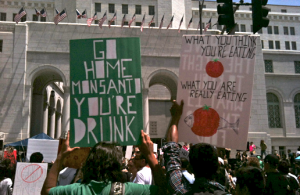
Buh Bye Monsanto – Why Even Your Agriculture Allies Won’t Miss This Brand
Ah, Monsanto. A name that comes with chills, jabs, jokes, memes and even Marches Against. Once research giant Monsanto’s $60 billion merger with Bayer is complete, the Monsanto brand will be retired – a move that many of us in the agriculture industry never thought we’d see, and for which we have waited too long.

As the child of a third generation family farmer… I grew up seeing Monsanto packages, bags, signs and other items around the farm that I later learned were an indication that farmers in my family were early adopters. Dad used seed, fertilizer, herbicides, pesticides and other innovations pioneered by Monsanto (and other companies) to increase his yields, reduce the amount of chemicals needed to control weeds and insects, and improve the soils for growing.
In the 90s, Dad embraced Monsanto’s Roundup Ready innovation, and he eventually planted 100 percent Roundup Ready beans – designed to resist the Roundup that killed weeds, but not the soybeans. This was amazing technology that meant kids like me never again had to walk a bean field yielding a weed-killing machete (scythe) to cut down Johnson grass!
To an agricultural customer… The brand carried many attributes family farms celebrate, such as technology, innovation, research, science, increased yields, profitability, precision decision-making, and affordability. Around 2005, I had the privilege to visit Monsanto’s corporate headquarters in St. Louis, Missouri to see the facilities and projects related to improving oilseeds for ethanol production. To a farm girl from Ohio, this topped seeing Silicon Valley for the first time a few years before.

It wasn’t long after — around the time Bill Nye the Science Guy started talking about Frankenfoods and GMOs were becoming a mainstream no-no — that “Monsanto” had become the ugliest word in world agriculture history.
Farmers were shocked to hear consumers talk about agriculture with a vitriol we had never heard about our industry.
The negative feelings that anti-GMO activists and their unwitting accomplices spewed about Monsanto landed directly on the average American farmer, who had been a happy customer for decades.
The brand had absorbed the attributes placed on it by consumer activists and mom bloggers who innocently thought that they were standing up to the Wall Street of Agriculture, rather than harming local farmers who thrived using their products. The brand became the center of the movement on which they hung images of big ag, corporate control, social disregard, poisoned waterways, government subsidies, lab-created food, antibiotic and pesticide resistance, and the struggle of the local farmer.
Our non-ag friends began to so easily toss around hatred for this evil empire, that the American farmer was caught off-guard with a point of view that paralyzed us from responding. So, we didn’t.
We sat in silence and took it. All the while, our reputation suffered, and we became – Monsanto became – exactly what they told us we were.
Through many changes in the last decade, farmers have developed self awareness about the need to proactively communicate, to question and challenge brands and leaders, to choose our battles wisely, to own the message that defines our industry, to be part of a two-way conversation about food, and to listen to concern in order to build trust.
The retirement of the Monsanto brand is due – like a co-worker who overstayed his useful work life. You did some notable – even game-changing – things along the way, but it’s time to go. Enjoy your life, transfer the knowledge to other brand identities, and release us from your baggage.
Happy Retirement, Monsanto!
